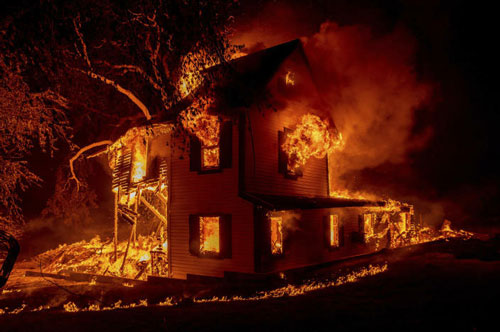Susanville, Calif
Firefighters faced more dangerously windy weather Tuesday as they struggled to keep the nation’s largest wildfire from moving toward a Northern California county seat and other small mountain communities.
Forecasters issued red flag warnings of critical fire weather conditions including gusts up to 40 mph (64 kph) from late morning to near midnight.
Winds spawned by a new weather system arrived Monday afternoon and pushed the Dixie Fire within a few miles of Susanville, population about 18,000, and prompted evacuation orders for the small nearby mountain community of Janesville, fire officials said.
“The fire moved fast last night,” fire spokesman David Janssen said early Tuesday.
Susanville is the seat of Lassen County and the largest city that the Dixie Fire, named for the road where it started, has approached since it broke out last month.
The former Sierra Nevada logging and mining town has two state prisons, a nearby federal lockup and a casino.
Ash fell from the advancing fire and a Police Department statement urged residents “to be alert and be ready to evacuate” if the fire threatens the city, although no formal evacuation warning had been issued.
Bulldozers had cut fire lines in the path of the northward-trending blaze. “We really had our fire lines challenged,” Janssen said. “This is a really big fire. It’s really hard to button up the perimeters.”
The weather forecast prompted Pacific Gas & Electric to warn that it might cut off power to 48,000 customers in portions of 18 California counties from Tuesday evening through Wednesday afternoon to prevent winds from knocking down or hurling debris into power lines and sparking new wildfires.
Most of those customers are in Butte and Shasta counties, which have seen a number of deadly and devastating wildfires in recent years, including the Dixie Fire.
The Dixie Fire has scorched more than 900 square miles (2,331 square kilometers) in the northern Sierra Nevada and southern Cascades since it ignited on July 13 and eventually merged with a smaller blaze called the Fly Fire. It’s less than a third contained..
Investigations are continuing, but PG&E has notified utility regulators that the Dixie and Fly fires may have been caused by trees falling into its power lines.
The Dixie Fire began near the town of Paradise, which was devastated by a 2018 wildfire ignited by PG&E equipment during strong winds. Eighty-five people died.
Ongoing damage surveys have counted more than 1,100 buildings destroyed, including 627 homes, and more than 14,000 structures remained threatened. Numerous evacuation orders were in effect.
The small lumber town of Westwood was still under evacuation orders and protective lines were holding but the blaze remained a threat.
California was dealing with several other massive fires, including one called the Caldor Fire that started on Saturday southeast of the Dixie Fire in El Dorado County that has grown to about 10 square miles (26 square kilometers).
About 2,500 people are under evacuation orders and warnings because of the Caldor Fire, which nearly tripled in size overnight, said Chris Vestal, a fire spokesman.
The Dixie Fire is the largest of nearly 100 major wildfires burning across more than a dozen Western states that have seen historic drought and weeks of high temperatures and dry weather that have left trees, brush and grasslands as flammable as tinder.
Two dozen fires were burning in Montana and nearly 50 more in Idaho, Washington and Oregon, according to the National Fire Interagency Center.
In Montana, a fire near the small community of Hays that began on Monday had burned about 8 square miles (20 square kilometers) and residents in and around the tiny enclave of Zortman were put on notice for possible evacuation.—AP










